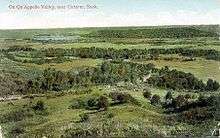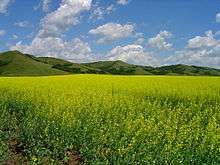Qu'Appelle River
| Qu'Appelle River | |
 Qu'Appelle Valley panorama | |
| Country | Canada |
|---|---|
| Provinces | Saskatchewan, Manitoba |
| Part of | Red River drainage basin |
| Source | Lake Diefenbaker |
| - location | at Qu'Appelle River Dam, Saskatchewan. |
| - elevation | 550 m (1,804 ft) |
| - coordinates | 50°58′30″N 106°26′02″W / 50.97500°N 106.43389°W |
| Mouth | Assiniboine River |
| - location | near St. Lazare, Manitoba. |
| - elevation | 400 m (1,312 ft) |
| - coordinates | 50°26′38″N 101°19′11″W / 50.44389°N 101.31972°WCoordinates: 50°26′38″N 101°19′11″W / 50.44389°N 101.31972°W |
| Length | 430 km (267 mi) |
| Basin | 51,000 km2 (19,691 sq mi) |
 The Red River drainage basin, with the Qu'Appelle River highlighted | |
| [1][2][3][4] | |
The Qu'Appelle River /kəˈpɛl/ is a Canadian river that flows 430 kilometres (270 mi) east from Lake Diefenbaker in southwestern Saskatchewan to join the Assiniboine River in Manitoba, just south of Lake of the Prairies, near the village of St. Lazare.
With the construction of the Qu'Appelle River Dam and Gardiner Dam upstream water flow was significantly increased and regulated. Most of the Qu'Appelle's present flow is actually water diverted from the South Saskatchewan River.
Description
The river flows into several lakes in southeast Saskatchewan, including:
- Eyebrow Lake, Buffalo Pound Lake to the north of Moose Jaw, which supplies water to Moose Jaw, Regina, and the Mosaic Potash Mine at Belle Plaine;
- The Fishing Lakes (Pasqua, Echo, Mission, and Katepwa lakes) to the northeast of Regina; and,
- farther downstream, to the north of Grenfell and Broadview: Crooked Lake and Round Lake.
The river also passes four provincial parks: Buffalo Pound Provincial Park, Echo Valley Provincial Park, Katepwa Point Provincial Park and Crooked Lake Provincial Park.

Assorted tributary coulees drain into the Qu'Appelle Valley at various junctures along its course, notably Echo Creek immediately upriver from Fort Qu'Appelle, and Last Oak Creek, north of Grenfell and Broadview, in the past the locus of an extremely successful aboriginal-managed ski resort. The other tributaries include the Moose Jaw River, Wascana Creek, Loon Creek, Jumping Deer Creek, Pheasant Creek, Kaposvar Creek and Lanigan Creek.
Last Mountain Lake, also known as Long Lake, the largest natural lake in southern Saskatchewan (Lake Diefenbaker is larger but is a reservoir behind the Gardiner and Qu'Appelle River Dams), drains into the Qu'Appelle near the town of Craven, through Lanigan Creek.
History

In 1787, the North West Company established a fur trading post at Fort Espérance on the lower river. After it was abandoned in 1819, the Hudson's Bay Company established a post at Fort Qu'Appelle in 1852 immediately adjacent to the site of what became the town of the same name.
The Qu'Appelle River and Valley derive their name from a Cree legend of a spirit that travels up and down it. The aboriginal people told the North West Company trader Daniel Harmon in 1804 that they often heard the voice of a human being calling, "Kâ-têpwêt?", meaning "Who is calling?" ("Qui appelle?" in French). They would respond, and the call would echo back (there is a strong echo phenomenon at Lebret). Pauline Johnson, the half-Mohawk poet, whose "work was well received by critics and was popular with the public during her lifetime, but faded into obscurity after her death,"[5] and who made speaking tours of Canada, the United States, and England between 1892 and 1909, learned of the legend and elaborated upon it with Victorian sentiment. In her version, a young Cree swain heard his name while crossing one of the lakes and replied, "Who calls?" Only his echo could be heard (hence Echo Lake), and he realized it had been his bride-to-be calling out his name at the instant of her death. Despite its evidently fictional nature, it is the trumped-up romantic version that holds sway today. In recent years, there has been some local civic-booster agitation to rename the Fishing Lakes as the Calling Lakes, so as further to emphasize E. Pauline Johnson's "legend of the Qu'Appelle Valley"; as yet this has not taken any authentic hold.
Recreation and environment
 Como Park, in resort village of Sandy Beach on Katepwa Lake, 1920s.
Como Park, in resort village of Sandy Beach on Katepwa Lake, 1920s. Qu'Appelle River, Fort Qu'Appelle, circa 1910
Qu'Appelle River, Fort Qu'Appelle, circa 1910 Fort Qu'Appelle, circa 1910
Fort Qu'Appelle, circa 1910
In addition to the popularity of its lakes as summer recreational locales, the valley also contains popular venues for winter sports including the following:
- White Track ski resort on Buffalo Pound Lake
- Mission Ridge Winter Park, a popular skiing and snowboarding destination on the south shore of Mission Lake immediately adjacent to Fort Qu'Appelle
- Last Oak Golf Course to the north of Broadview, some 80 miles (130 km) east of Regina
- Hang gliding (and, less often, paragliding) from the valley slopes, especially in the Crooked Lake and Round Lake regions. In this area the valley is up to 450 feet (140 m) deep and a mile wide, allowing for strong, smooth airflow up the side of the valley and ample landing areas on top and down in the valley, and providing a strong upward component of wind as it flows over the (in some places) optimally rounded valley edge, allowing pilots to soar in the "ridge lift" for many hours at a time. Pilots commonly travel from Manitoba and Alberta and of course other locations in Saskatchewan to fly this natural wonder of the prairies.
- The river valley contains relatively undisturbed grassland and coulees which provide habitat for native plant and animal species, such as the loggerhead shrike and the coyote (locally /ˈkaɪ.oʊt/). The easternmost slopes contain bur oaks, the only natural occurrence of oak trees in Saskatchewan.[6]
Fish
Fish species include: walleye, sauger, yellow perch, northern pike, lake whitefish, cisco, mooneye, white sucker, shorthead redhorse, bigmouth buffalo, common carp, channel catfish, black bullhead, brown bullhead, burbot and rock bass. Rock bass are Saskatchewan's only native bass.
Notable residents

- James Henderson, the pre-eminent first-generation Saskatchewan artist, spent the latter part of his life in Fort Qu'Appelle, painting valley landscapes and aboriginal portraits until his death in 1951.
- The folksinger and activist Buffy Sainte-Marie was born on the Piapot Cree Reserve in the Qu'Appelle Valley. One of her songs is entitled "Qu'Appelle Valley, Saskatchewan".
See also
Notes
- ↑ "Natural Resources Canada-Canadian Geographical Names (Qu'Appelle River)". Retrieved 2014-08-29.
- ↑ "Atlas of Canada Toporama". Retrieved 2014-08-29.
- ↑ The Encyclopedia of Saskatchewan. "Qu'Appelle River". Retrieved 2008-08-02.
- ↑ "Canada Drainage Basins". The National Atlas of Canada, 5th edition. Natural Resources Canada. 1985. Retrieved 24 November 2010.
- ↑ Harriet Gorham, "Johnson, E. Pauline," Encyclopedia of Canada. Retrieved 19 November 2007.
- ↑ Norm Henderson, "Qu'Appelle Valley," Encyclopedia of Saskatchewan. Retrieved 19 November 2007.
External links
- Encyclopedia of Saskatchewan
- Buffalo Pound Provincial Park
- Echo Valley Provincial Park
- Katepwa Point Provincial Park
- Crooked Lake Provincial Park
Gallery
 Qu'Appelle Valley near Cutarm, 1910
Qu'Appelle Valley near Cutarm, 1910 B-Say-Tah Point on Echo Lake in the Qu'Appelle Valley, a popular holiday resort and commuter community for Reginans since the 1880s
B-Say-Tah Point on Echo Lake in the Qu'Appelle Valley, a popular holiday resort and commuter community for Reginans since the 1880s Buffalo Pound Lake
Buffalo Pound Lake Echo Creek, arising immediately north of the town of Qu'Appelle and draining into the Qu'Appelle Valley at Fort Qu'Appelle
Echo Creek, arising immediately north of the town of Qu'Appelle and draining into the Qu'Appelle Valley at Fort Qu'Appelle The Qu'Appelle Valley under cultivation in South East Saskatchewan
The Qu'Appelle Valley under cultivation in South East Saskatchewan